
Placodermi is a class of armoured prehistoric fish, known from fossils, which lived from the Silurian to the end of the Devonian period. Their head and thorax were covered by articulated armoured plates and the rest of the body was scaled or naked, depending on the species. Placoderms were among the first jawed fish; their jaws likely evolved from the first of their gill arches.
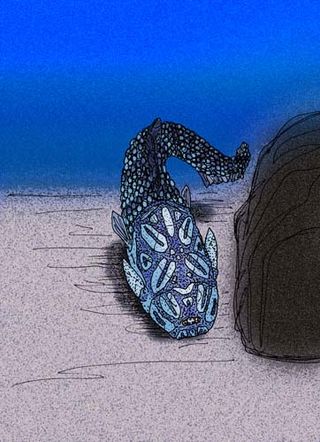
Mizia is a genus of primitive antiarch placoderm found in Emsian-aged marine strata of Early Devonian China.

Bothriolepis was a widespread, abundant and diverse genus of antiarch placoderms that lived during the Middle to Late Devonian period of the Paleozoic Era. Historically, Bothriolepis resided in an array of paleo-environments spread across every paleocontinent, including near shore marine and freshwater settings. Most species of Bothriolepis were characterized as relatively small, benthic, freshwater detritivores, averaging around 30 centimetres (12 in) in length. However, the largest species, B. rex, had an estimated bodylength of 170 centimetres (67 in). Although expansive with over 60 species found worldwide, comparatively Bothriolepis is not unusually more diverse than most modern bottom dwelling species around today.

Petalichthyida is an extinct order of small, flattened placoderm fish. They are typified by their splayed pectoral fins, exaggerated lateral spines, flattened bodies, and numerous tubercles that decorated all of the plates and scales of their armor. They reached a peak in diversity during the Early Devonian and were found throughout the world, particularly in Europe, North America, Asia, South America, and Australia. The petalichthids Lunaspis and Wijdeaspis are among the best known. The earliest and most primitive known petalichthyid is Diandongpetalichthys, which is from earliest Devonian-aged strata of Yunnan. The presence of Diandongpetalichthys, along with other primitive petalichthyids including Neopetalichthys and Quasipetalichthys, and more advanced petalichthyids, suggest that the order may have arisen in China, possibly during the late Silurian.

Rhenanida is an order of scaly placoderms. Unlike most other placoderms, the rhenanids' armor was made up of a mosaic of unfused scales and tubercles. The patterns and components of this "mosaic" correspond to the plates of armor in other, more advanced placoderms, suggesting that the ancestral placoderm had armor made of unfused components, as well.

Antiarchi is an order of heavily armored placoderms. The antiarchs form the second-most successful group of placoderms after the arthrodires in terms of numbers of species and range of environments. The order's name was coined by Edward Drinker Cope, who, when examining some fossils that he thought were armored tunicates related to Chelyosoma, mistakenly thought that the orbital fenestra was the opening for the mouth, or oral siphon, and that the opening for the anal siphon was on the other side of the body, as opposed to having both oral and anal siphons together at one end.
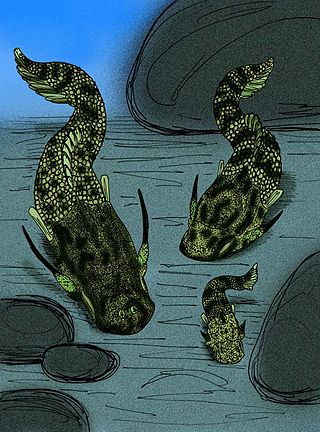
Minicrania is an extinct genus of tiny antiarch fish, with armor averaging up to about 2 centimetres (0.79 in) long, which lived during the Lochkovian epoch in Early Devonian Yunnan Province, China and northern Vietnam.

The Gogo Formation in the Kimberley region of Western Australia is a Lagerstätte that exhibits exceptional preservation of a Devonian reef community. The formation is named after Gogo Station, a cattle station where outcrops appear and fossils are often collected from, as is nearby Fossil Downs Station.
Gavinaspis is a phyllolepid placoderm which lived during the Early Devonian period, of Qujing, Yunnan province, south China.
The Xitun Formation is a palaeontological formation which is named after Xitun village in Qujing, a location in South China. This formation includes many remains of fossilized fish and plants of the Early Devonian period. It was originally referred to as the Xitun Member of the Cuifengshan Formation.

Quasipetalichthys haikouensis is the type and only known species of the extinct petalichthid placoderm, Quasipetalichthys. Fossil remains of Quasipetalichthys have been found in the Middle Devonian, Givetian faunal stage of China.
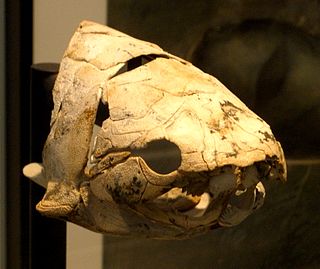
Eastmanosteus is a fossil genus of dunkleosteid placoderms. It was closely related to the giant Dunkleosteus, but differed from that genus in size, in possessing a distinctive tuberculated bone ornament, a differently shaped nuchal plate and a more zig-zagging course of the sutures of the skull roof.
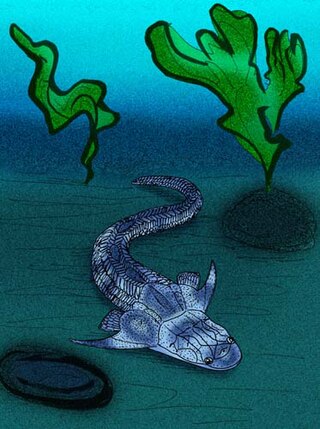
Diandongpetalichthys liaojiaoshanensis is an extinct petalichthyid placoderm from the Early Devonian of China.
Meemann Chang also known as Zhang Miman, is a Chinese paleontologist at the Institute of Vertebrate Paleontology and Paleoanthropology (IVPP). She completed her undergraduate studies at Moscow University and completed her PhD thesis entitled 'The braincase of Youngolepis, a Lower Devonian crossopterygian from Yunnan, south-western China' at Stockholm University. She was the first woman to become head of IVPP in 1983. For her many career achievements, she received an honorary degree from the University of Chicago in 2011 and the Romer-Simpson Medal from the Society of Vertebrate Paleontology in 2016.

Wufengshania is an extinct genus of bothriolepidid placoderm from the Emsian epoch of China. The type species, Wufengshania magniforaminiswas named by Zhaohui Pan et al., 2018.
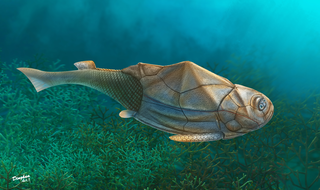
Phymolepis is an extinct genus of yunnanolepidid placoderm from the Early Devonian of China. The type species, P. cuifengshanensis, was named by Zhang Goroui in 1978 and was re-evaluated in 2018, while a second species, P. guoruii, was named and described in 1996.
Westralichthys is an extinct monospecific genus of dunkleosteoid from the Late Devonian: Middle Famennian stage from Western Australia. It is estimated to be 3 meters (9.8 ft) long.
This list of fossil fish research presented in 2023 is a list of new taxa of jawless vertebrates, placoderms, acanthodians, fossil cartilaginous fishes, bony fishes, and other fishes that were described during the year, as well as other significant discoveries and events related to paleoichthyology that occurred in 2023.

Bothriolepididae is a family of antiarch placoderms, known from the Emsian, to Famennian.














